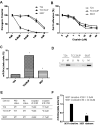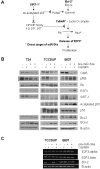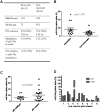MiR-34a chemosensitizes bladder cancer cells to cisplatin treatment regardless of p53-Rb pathway status
- PMID: 21702042
- PMCID: PMC4568996
- DOI: 10.1002/ijc.26256
MiR-34a chemosensitizes bladder cancer cells to cisplatin treatment regardless of p53-Rb pathway status
Abstract
MiR-34a is a downstream effector of p53 that has been shown to target several molecules associated with cell cycle and cell survival pathways. As alterations in these pathways are frequent in muscle invasive transitional cell carcinoma of the bladder (MI-TCC), for example mutation or loss of p53 and Rb, the goal of this study was to determine whether manipulation of miR-34a expression levels could abrogate the effect of these alterations and sensitize bladder cancer cells to chemotherapy. We demonstrate that transfection of T24, TCCSUP and 5637 with pre-miR-34a followed by cisplatin treatment results in a dramatic reduction in clonogenic potential and induction of senescence compared to treatment with cisplatin alone. Molecular analyses identified Cdk6 and sirtuin (SIRT)-1 as being targeted by miR-34a in MI-TCC cells, however, inhibition of Cdk6 and SIRT-1 was not as effective as pre-miR-34a in mediating chemosensitization. Analysis of 27 preneoadjuvant chemotherapy patient samples revealed many of the patients who subsequently did not respond to treatment (based on surgical resection postchemotherapy and 5-year survival data) express lower levels of miR-34a, however, a statistically significant difference between the responder and nonresponder groups was not observed (p = 0.1174). Analysis of eight sets of pre- and postneoadjuvant chemotherapy patient samples determined miR-34a expression increased postchemotherapy in only two of the eight patients. The combined data indicate that elevation of miR-34a expression levels before chemotherapy would be of benefit to MI-TCC patients, particularly in a setting of low miR-34a expression.
Copyright © 2011 UICC.
Figures






Similar articles
-
Cisplatin-induced epigenetic activation of miR-34a sensitizes bladder cancer cells to chemotherapy.Mol Cancer. 2014 Jan 15;13:8. doi: 10.1186/1476-4598-13-8. Mol Cancer. 2014. PMID: 24423412 Free PMC article.
-
Obatoclax, a BH3 Mimetic, Enhances Cisplatin-Induced Apoptosis and Decreases the Clonogenicity of Muscle Invasive Bladder Cancer Cells via Mechanisms That Involve the Inhibition of Pro-Survival Molecules as Well as Cell Cycle Regulators.Int J Mol Sci. 2019 Mar 14;20(6):1285. doi: 10.3390/ijms20061285. Int J Mol Sci. 2019. PMID: 30875757 Free PMC article.
-
Expression of microRNAs in urinary bladder samples obtained from dogs with grossly normal bladders, inflammatory bladder disease, or transitional cell carcinoma.Am J Vet Res. 2012 Oct;73(10):1626-33. doi: 10.2460/ajvr.73.10.1626. Am J Vet Res. 2012. PMID: 23013190
-
Differential microRNA-34a expression and tumor suppressor function in retinoblastoma cells.Invest Ophthalmol Vis Sci. 2009 Oct;50(10):4542-51. doi: 10.1167/iovs.09-3520. Epub 2009 May 14. Invest Ophthalmol Vis Sci. 2009. PMID: 19443717
-
p53 and retinoblastoma pathways in bladder cancer.World J Urol. 2007 Dec;25(6):563-71. doi: 10.1007/s00345-007-0197-0. Epub 2007 Aug 21. World J Urol. 2007. PMID: 17710407 Review.
Cited by
-
Estrogen receptor-β signaling induces cisplatin resistance in bladder cancer.Am J Cancer Res. 2020 Aug 1;10(8):2523-2534. eCollection 2020. Am J Cancer Res. 2020. PMID: 32905529 Free PMC article.
-
Multifunctional targeting micelle nanocarriers with both imaging and therapeutic potential for bladder cancer.Int J Nanomedicine. 2012;7:2793-804. doi: 10.2147/IJN.S27734. Epub 2012 Jun 6. Int J Nanomedicine. 2012. PMID: 22745542 Free PMC article.
-
Contemporary Molecular Markers for Predicting Systemic Treatment Response in Urothelial Bladder Cancer: A Narrative Review.Cancers (Basel). 2024 Sep 1;16(17):3056. doi: 10.3390/cancers16173056. Cancers (Basel). 2024. PMID: 39272913 Free PMC article. Review.
-
Emerging strategies for the improvement of chemotherapy in bladder cancer: Current knowledge and future perspectives.J Adv Res. 2022 Jul;39:187-202. doi: 10.1016/j.jare.2021.11.010. Epub 2021 Nov 24. J Adv Res. 2022. PMID: 35777908 Free PMC article. Review.
-
MicroRNA function in the profibrogenic interplay upon chronic liver disease.Int J Mol Sci. 2014 May 27;15(6):9360-71. doi: 10.3390/ijms15069360. Int J Mol Sci. 2014. PMID: 24871365 Free PMC article. Review.
References
-
- Herr HW, Dotan Z, Donat SM, Bajorin DF. Defining optimal therapy for muscle invasive bladder cancer. The Journal of urology. 2007;177:437–43. - PubMed
-
- Baffa R, Letko J, McClung C, LeNoir J, Vecchione A, Gomella LG. Molecular genetics of bladder cancer: targets for diagnosis and therapy. J Exp Clin Cancer Res. 2006;25:145–60. - PubMed
-
- Raghavan D. Molecular targeting and pharmacogenomics in the management of advanced bladder cancer. Cancer. 2003;97:2083–9. - PubMed
-
- Shariat SF, Bolenz C, Karakiewicz PI, Fradet Y, Ashfaq R, Bastian PJ, Nielsen ME, Capitanio U, Jeldres C, Rigaud J, Muller SC, Lerner SP, et al. p53 expression in patients with advanced urothelial cancer of the urinary bladder. BJU Int. 105:489–95. - PubMed
MeSH terms
Substances
Grants and funding
LinkOut - more resources
Full Text Sources
Other Literature Sources
Medical
Research Materials
Miscellaneous

